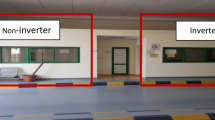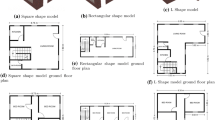Abstract
Given the ever-increasing people’s need for housing, affordable housing and environmental comfort are important, and the use of inactive design methods is the cheapest solution to achieve low-energy buildings. This study aimed at understanding the natural ventilation potential in Gorgan. This research has been conducted aiming at providing solutions based on airflow to reduce energy consumption in the building for the warm months of the year. Solutions for using natural ventilation in the design of a residential complex include a terrace, void, direct ventilation for the corridors, cross ventilation, and arranging the units to get suitable ventilation. The energy influence the air through the intermediate spaces of the floor units; as the external consumption during the warm period of the year was simulated in the form of an applied project. In this research, a model with mechanical ventilation and 4 patterns of 22 modes were designed using natural ventilation. The results showed that the factors such as using void, stair layout of the plan, using semi-empty spaces in the building, creating internal lateral ventilation, being the interior doors opened, placing the smaller unit from west to south, the connection between the kitchen and the living space in the building causes a reduction of the energy consumption in the warm seasons of the year in moderate and humid climates.









Source of the basic chart: (Farrokhzad 2013)—Drawn by the authors

Source: Authors


(Source: authors)

(Source: authors)

(Source: authors)

(Source: authors)


Source: Authors

Source: Authors

Source: Authors

Source: Authors

Source: Authors

Source: authors

Similar content being viewed by others
References
Allard, F., & Ghiaus, C. (2012). Natural ventilation in the urban environment: assessment and design. London: Routledge.
Almusaed, A. (2011). Biophilic and bioclimatic architecture: Analytical therapy for the next generation of passive sustainable architecture. In Biophilic and bioclimatic architecture: Analytical therapy for the next generation of passive sustainable architecture. https://doi.org/10.1007/978-1-84996-534-7
Arab, M., & Farrokhzad, M. (2017). Feasibility of designing of earth sheltered architecture with principles of sustainable architecture to reduce building energy consumption in warm and dry climate; case study: Shahroud City. Journal of Energy Policy and Planning Research, 3(8), 147–173.
Davarinezhad Moghaddam, M., & Solbi, M. (2011). Investigating the effect of climatic factors on vernacular architecture (case study: Gorgan). 1st Conference on Permanent Building. https://www.civilica.com/Paper-BANA01-BANA01_054.html
DesignBuilder Help ver.5.4. (n.d.). https://designbuilder.co.uk/helpv5.5/
Esmaeili, S. (2016). The manner of the effect of openings on natural ventilation in order to optimizing energy consumption in traditional houses of Mazandaran (case study: Kandelous village). In 4th International Conference on Modern Researches in Civil Engineering, Architecture and Urbanism.
Etheridge, D. (2012). Natural ventilation of buildings: Theory, measurement and design. London: Wiley.
Farea, T. G., Ossen, D. R., Alkaff, S., & Kotani, H. (2015). CFD modeling for natural ventilation in a lightwell connected to outdoor through horizontal voids. Energy and Buildings. https://doi.org/10.1016/j.enbuild.2014.10.030.
Farrokhzad, M. (2013). The effects of sustainable architecture principles on the design of the Arsh Twin Towers in the Farahzadi region of Tehran. Tehran
Fordham, M. (2000). Wind Towers by Battle McCarthy Engineers. Architectural Research Quarterly. https://doi.org/10.1017/s1359135500002499.
Ghafari Jabari, S., Ghafari Jabari, S., & Saleh, E. (2013). Review strategies for improving the design and construction of settlements in Tehran. Quarterly Journal of Energy Policy and Planning Research, 1(1), 115–132.
Givoni, B. (1998). Climate considerations in building and urban design. London: Wiley.
IRIMO. (2015). Iran Meteorological Data. www.irimo.ir
Irving, S., Ford, B., & Etheridge, D. (2005). Natural ventilation in non-domestic buildings. In CIBSE Applications Manual AM10. London: Chartered Institution of Building Services Engineers.
Ismail, A. M. (1996). Wind-driven natural ventilation in high-rise office buildings with special reference to the hot-humid climate of Malaysia. Cardiff: Cardiff University.
Kasmaei, M. (2009). Climatic design, zoning and guidelines for moderate climates (Gilan and Mazandaran Provinces). In Building and Housing Research Center. Tehran: BHRC.
Kasmaei, M. (2012). Climate and Architecture. Isfahan: In Khak publication.
Khoori, Z., Farrokhzad, M., & Nazif, H. (2017). Climatic design indicators of residential buildings in Gorgan. In 5th International Congress on Civil Engineering, Architecture and Urban Development.
Kotani, H., Satoh, R., & Yamanaka, T. (2003). Natural ventilation of light well in high-rise apartment building. Energy and Buildings. https://doi.org/10.1016/S0378-7788(02)00166-4.
Kuczyński, T., & Staszczuk, A. (2020). Experimental study of the influence of thermal mass on thermal comfort and cooling energy demand in residential buildings. Energy. https://doi.org/10.1016/j.energy.2020.116984.
Milne, M., & Givoni, B. (1979). Architectural design based on climate. In W. Donald (Ed.), Energy conservation through building design (pp. 96–113). New York: McGraw-Hill.
Mozaffari Ghadikolaei, F., Ossen, D. R., & Mohamed, M. F. (2020). Effects of wing wall at the balcony on the natural ventilation performance in medium-rise residential buildings. Journal of Building Engineering. https://doi.org/10.1016/j.jobe.2020.101316.
Muhsin, F., Yusoff, W. F. M., Mohamed, M. F., & Sapian, A. R. (2017). CFD modeling of natural ventilation in a void connected to the living units of multi-storey housing for thermal comfort. Energy and Buildings. https://doi.org/10.1016/j.enbuild.2017.03.035.
Murakami, S., Kato, S., Ooka, R., & Shiraishi, Y. (2004). Design of a porous-type residential building model with low environmental load in hot and humid Asia. Energy and Buildings. https://doi.org/10.1016/j.enbuild.2003.08.001.
Omrani, S., Garcia-Hansen, V., Capra, B. R., & Drogemuller, R. (2017). On the effect of provision of balconies on natural ventilation and thermal comfort in high-rise residential buildings. Building and Environment. https://doi.org/10.1016/j.buildenv.2017.07.016.
Roshan, G., Farrokhzad, M., & Attia, S. (2019). Climatic clustering analysis for novel atlas mapping and bioclimatic design recommendations. Indoor and Built Environment. https://doi.org/10.1177/1420326X19888572.
Saadatjoo, P., Mahdavinejad, M., & Zhang, G. (2018). A study on terraced apartments and their natural ventilation performance in hot and humid regions. Building Simulation. https://doi.org/10.1007/s12273-017-0407-7.
Smith, P. (2005). Architecture in a climate of change. Architectural Press An imprint of Elsevier.
Tahbaz, M., & Jalilian, S. (2011). The role of architectural design in energy saving of building (Wind energy in architecture). Tehran: Academic-applied science center of Rahshahr international group.
van Hooff, T., & Blocken, B. (2012). Full-scale measurements of indoor environmental conditions and natural ventilation in a large semi-enclosed stadium: Possibilities and limitations for CFD validation. Journal of Wind Engineering and Industrial Aerodynamics. https://doi.org/10.1016/j.jweia.2012.02.009.
Yu, C. R., Guo, H. S., Wang, Q. C., & Chang, R. D. (2020). Revealing the impacts of passive cooling techniques on building energy performance: A residential case in Hong Kong. Applied Sciences (Switzerland). https://doi.org/10.3390/APP10124188.
Author information
Authors and Affiliations
Corresponding author
Additional information
Publisher's Note
Springer Nature remains neutral with regard to jurisdictional claims in published maps and institutional affiliations.
Rights and permissions
About this article
Cite this article
Khajavi, F., Farrokhzad, M. & Hosseini, S.E. Controlling energy consumption in residential buildings using air infiltration in humid climates. Environ Dev Sustain 23, 15118–15144 (2021). https://doi.org/10.1007/s10668-021-01288-1
Received:
Accepted:
Published:
Issue Date:
DOI: https://doi.org/10.1007/s10668-021-01288-1




